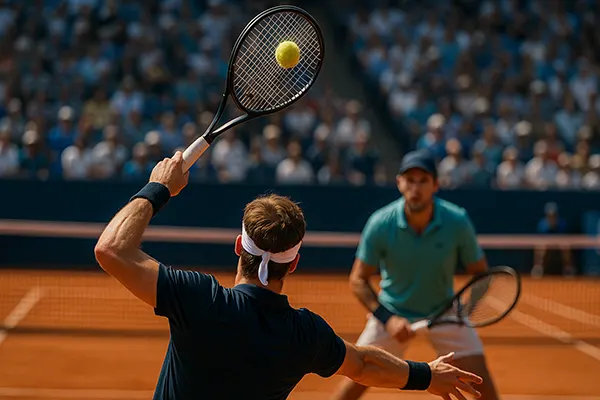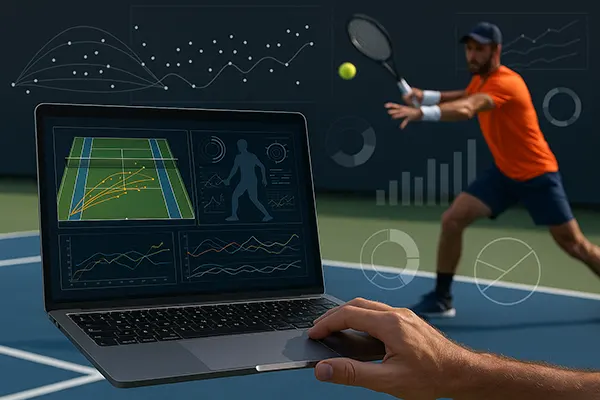Momentum in tennis is one of the most intriguing yet elusive elements of the sport. Unlike pure statistics such as serve percentages or unforced errors, momentum reflects the psychological and tactical shifts that occur during a match. In recent years, analysts and data scientists have sought to quantify momentum, recognising its value for both professional coaching and predictive modelling. This article explores how momentum works, how it can be measured, and why understanding it matters for players and analysts alike.
What Is Momentum in Tennis?
Momentum in tennis goes beyond a simple sequence of winning points or games. It represents the psychological pressure one player exerts over another, often after a turning point such as breaking serve or saving multiple break points. Unlike a streak, momentum involves a change in the flow of the match, where confidence rises for one player and declines for the other.
Analysts distinguish momentum from streaks because streaks may occur in isolation, while momentum usually has a cumulative impact on the remainder of the contest. For example, a player winning three points in a row does not necessarily hold momentum unless it influences the opponent’s body language and future performance.
Modern analysis frames momentum as a combination of mental resilience, tactical decisions, and physical endurance. This makes it particularly relevant for best-of-five encounters in Grand Slams, where matches can swing dramatically over several hours.
How Analysts Define Momentum
Researchers use concepts from psychology and statistics to describe momentum. They highlight the shift in probability of winning the next point, based not only on skill but also on situational factors such as crowd influence or recovery after a long rally. Momentum is therefore dynamic, depending on both quantitative data and qualitative aspects of the game.
State-space models, for instance, allow experts to track momentum as it shifts between players. Unlike static measures, these models account for transitions between advantageous and disadvantageous states within a rally, game, or set. This gives a layered perspective on how control changes hands.
By combining match data with behavioural indicators, analysts can create a more holistic picture of momentum that goes beyond traditional statistics.
Methods of Measuring Momentum
Different methods exist to measure momentum, each with its strengths. One of the earliest approaches involved sliding window techniques, where analysts looked at sequences of points or games to estimate the balance of play. While useful, this method often overlooked sudden shifts triggered by specific events.
Recent advances include machine learning models such as HydraNet, which can process multi-level dynamics, capturing momentum swings over rallies, games, and sets. These models leverage large datasets, including player positioning and shot selection, to identify when a player has gained or lost momentum.
Attention-based mechanisms have also been applied, allowing algorithms to focus on critical points, such as break opportunities or tie-breaks, where momentum changes are most pronounced. This ensures that momentum is not treated as linear but as a contextual factor in match analysis.
Case Studies from Professional Matches
Consider Rafael Nadal’s comeback wins on clay. His ability to regain momentum after losing a set is often tied to strategic adjustments, such as targeting an opponent’s weaker wing. Analysts studying these matches note that once Nadal shifts momentum, it can sustain him for multiple sets.
Another example comes from Novak Djokovic, who is renowned for neutralising his opponent’s momentum with defensive resilience. By extending rallies and absorbing pressure, he often forces a reset, undermining the psychological advantage of his rivals.
These examples show how momentum is not abstract but rooted in tangible shifts in play. Breaks of serve, clutch points, and tactical re-alignments all contribute to these turning moments.

Integrating Momentum into Strategy and Predictions
Understanding momentum has practical applications for both players and analysts. Coaches may use live match data to advise players when momentum is slipping, suggesting tactical adjustments such as varying serve placement or increasing net approaches. This helps to interrupt the opponent’s rhythm.
In predictive modelling, momentum is increasingly used alongside traditional player statistics. Betting analysts and AI-driven platforms assess not just “who is stronger” but “who currently benefits from a positive swing.” This nuance can improve the accuracy of live forecasts.
For players, recognising when momentum is turning against them is vital. Strategies such as slowing down between points, taking medical timeouts, or using crowd interaction can help reset the match dynamics.
Limitations and Contextual Factors
Momentum does not always behave consistently across different conditions. On faster surfaces like grass, where points are shorter, shifts may occur more abruptly but also disappear quickly. On clay, with longer rallies, momentum tends to accumulate more gradually.
Psychological weight also matters. In finals or high-pressure matches, momentum swings can be exaggerated due to nerves, while in early-round matches, players may recover more easily from setbacks. This shows that context is as important as raw numbers.
Finally, while models capture probabilities, tennis remains unpredictable. Injuries, weather conditions, and crowd involvement can all override expected momentum patterns, reminding us that sport resists full mathematical control.




